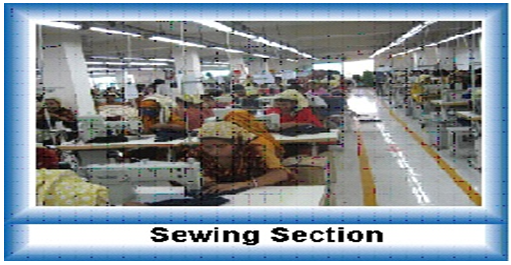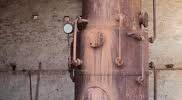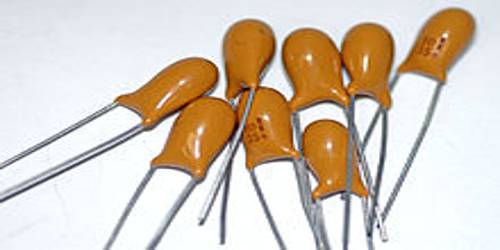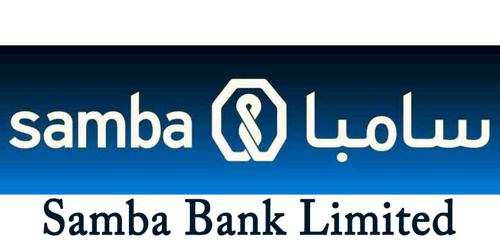SEWING SECTION
Sewing:
The process of joining fabric or seam is called Sewing.
Elements of Sewing:
- Sewing Thread,
- Needle &
- Sewing Machine
Flow-Sequence of Sewing Section:
- Cutting fabric load in sewing section
- Line plan according to style or design
- Marking
- Matching according to bundle no.
- Sewing according to Gmts design or style
- Quality inspection during sewing
- Quality inspection after sewing
- Excess Thread cutting
- Remove dirt & dust from Gmts surface
- Quality Audit
Send to next process

List of machinery found in sewing lines:
| Sewing Section | |||
| REF NO. | Equipments Types | BRAND | |
| 1 | Smoking machine 31 head | Kansai | |
| 2 | Feed of the arm | Brother | |
| 3 | Back stitch machine 2/N | Brother | |
| 4 | Angular stitch machine 2/N | Brother | |
| 5 | Over lock machine | Pegasus | |
| 6 | Kansai PMD 11/N | Kansai | |
| 7 | Button stitch machine | Brother | |
| 8 | Bartack machine | Brother | |
| 9 | Hot samsalin machine | Yang | |
| 10 | Flat lock machine | Kansai | |
| 11 | Pattern sewing machine | Sunstar | |
| 12 | Loop blind stitch machine | Treasure | |
| 13 | Blind stitch machine | Treasure | |
| 14 | Zigzag stitch machine | Brother | |
| 15 | Button hole machine | Brother | |
| 16 | Chain stitch machine | Brother | |
| 17 | P.K stitch machine | Zoje | |
| 18 | Loop kansai machine | Kansai | |
| 19 | Eye hole machine | Brother | |
| 20 | Snap button machine | NGAI shing | |
| 21 | Cone winder machine | Sunstar | |
| 22 | Boiler iron | Sunstar | |
| 23 | Steam iron | Sunstar | |
| 24 | Plain stitch machine | Juki | |
Properties of seam:
Properties of seam are assessed on the following aspects-
Appearance:
After sewing, the sewn area is observed for any defects, if present which affects outlook. Normally it is expected that there will be no defective view of stitches, seam pucker, or unsightly view.
Performance:
Performance of a seam is assessed according to following criteria-
- Seam Strength: Strength of a seam should be equal to or slightly less than the fabric strength.
- Seam elasticity: Elasticity property of a seam should be equal to or greater than the fabric elasticity.
- Durability: Durability of a seam equal to or greater than the durability of the fabric. Especially during wear and washing, the seam should not fail or damage due to frictional forces and tension.
- Security: During normal use of apparels, the seam should not fail due to simple reason. Confidence of normal stability of seam is the security of the seam. If the seam fails due to normal reason the situation might be undue.
- Comfort ability: Apparels, during normal use should not create any irritation or problem to body and health as well.
Special property: If clothing has any special property like water proof, fire proof, chemical resistant, etc then in manufacturing this apparel the seam should be produced in such away that the seams have also such special property.
Sewing Defects:
- Needle damage,
- Skip stitches,
- Thread Breakages,
- Broken Stitches
- Seam Grin
- Seam Puckering
- Pleated Seam
- Wrong stitch density
- Uneven stitch density
- Staggered stitch
- Improperly formed stitches
Line balancing:
Line balancing is the allocation of sewing machine according to style and design of garment. It depends of that what type of garment we have to produce.
The Objectives of Line Balancing:
Line balancing is a main part of a mass production. These kinds of systems, regardless of being different in details, are workstations in a sequence. Row material is included in the line at the beginning or in the middle. Parts included in the system transfers from one workstation through the other and at the end leaves the system as a completed product. Transfer lines uses manpower very little when compared to assembly lines. The certain properties of Transfer lines are transfer and process of a product automatically through a line.
Objectives that should be gained balancing an assembly line are as follows;
- Regular material flow;
- Maximum usage of man power and machine capacity;
- Minimum process times;
- Minimizing slack times;
- Minimizing workstations;
- Maximum outputs at the desired timed;
- Agreed quality maintenance of the garments;
- Reduce production costs.
Importance of Line Balancing:
The importance of line balancing could be summarized as follows –
Good line balancing increases the rate of production;
This is the pre-condition for smooth production;
Line balancing helps to compare the required machinery with the existing one and make a balance;
It also helps in the determination of labor requirement;
Good balancing reduces production time;
Profit of a factory can be ensured by proper line balancing;
Proper line balancing ensures optimum production at the agreed quality;
It reduces faults in the finished products;
Line balancing helps to know about new machines required for new styles;
It becomes easier to distribute particular job to each operator;
It becomes possible to deliver goods at right time at the agreed quality for least costs.
Steps in Line Balancing:
Now-a-days, Standard Minute Value (SMV) is used as a tool for the line balancing, production control and the estimation of efficiency. In a similar way, the time taken to do a job for making garments like shirt/trouser/blouse/dresses could depend upon a number of factors like –
- The length of the shirt/trouser/blouse/dress;
- The number of stitches per inch;
- The presentation of item;
- The pricing of garments. [8]
Example of Line balancing & SMV for short sleeve shirt:
OP. # | OPERATION | M/C | S.M.V. |
1 | BK PART MARK | H/W | 0.48 |
2 | BK SIDE PANNEL MAKE | S/N | 0.58 |
3 | BK SIDE PANNEL TOP STC | S/N | 0.48 |
4 | BK YOKE TWO PART JOIN | S/N | 0.84 |
5 | BK YOKE JOIN TOP STC | S/N | 0.52 |
6 | FRT PKT FLAP MARK & PAIR | H/W | 0.48 |
7 | FRT PKT FLAP MAKE | S/N | 0.84 |
8 | FRT PKT FLAP ROW EDGE CUT & TURN | H/W | 0.86 |
9 | FRT PKT FLAP TOP STC | S/N | 0.92 |
10 | FRT PKT FLAP EYE HOLE & MARK | EYE HOLE | 0.58 |
11 | FRT PKT & FLAP EDGE O/L | 3 THD O/L | 0.31 |
12 | FRT PKT FLAP DEC STC MARK | H/W | 0.38 |
13 | FRT PKT FLAP EDGE STC | S/N | 0.48 |
14 | FRT PKT HEM MAKE | S/N | 0.29 |
15 | FRT PKT IRON | H/W | 0.77 |
16 | FRT TOP & BTTM PLACKET O/L | 3 THD O/L | 0.53 |
17 | FRT TOP & BTTM PLACKET IRON | H/W | 0.68 |
19 | FRT TOP & BTTM PLACKET MAKE | S/N | 0.60 |
20 | FRT TOP & BTTM PLACKET MARK | H/W | 0.58 |
21 | FRT TOP & BTTM PLACKET JOIN | S/N | 0.68 |
22 | FRT TOP PLACKET TOP STC | S/N | 0.48 |
24 | FRT & BK PART ARRANGE & PAIR | H/W | 0.47 |
25 | SHOULDER JOIN | S/N | 0.72 |
26 | SHOULDER JOPIN TOP STC | S/N | 0.53 |
27 | SLEEVE JOIN WITH BODY | 5 THD O/L | 0.72 |
28 | SLEEVE JOIN TOP STC | S/N | 0.60 |
29 | FRT PKT & FLAP ATT. POSSITION MARK | H/W | 0.77 |
32 | FRT PKT & BODY PAIR | H/W | 0.48 |
33 | FRT PKT ATT. WITH BODY | D/N | 1.04 |
34 | FRT PKT FLAP ATT. & TOP STC | S/N | 0.68 |
35 | SLEEVE CUFF IRON | H/W | 0.73 |
36 | SLEEVE CUFF JOIN | S/N | 0.93 |
37 | SLEEVE CUFF JOIN TURN & TOP STC | S/N | 1.00 |
38 | SLEEVE CUFF CLOSE | S/N | 0.86 |
39 | SIDE SEAM JOIN WITH BODY | 5 THD O/L | 0.60 |
40 | BTTM HEM MAKE | S/N | 1.00 |
41 | BTTM HEM SIDE TAB IRON | H/W | 0.66 |
42 | BTTM HEM SIDE TAB BUTTON HOLE & MARK | HOLE M/C | 0.58 |
43 | BTTM HEM SIDE TAB ATT. | S/N | 0.86 |
44 | COLLAR TWO PART MAKE MARK & PAIR | H/W | 0.58 |
45 | COLLAR MAKE | S/N | 0.42 |
46 | COLLAR ROW EDGE CUT & TURN | H/W | 0.97 |
47 | LEBEL ATT. POSSITION MARK | H/W | 0.29 |
48 | LEBEL ATT. WITH BODY | S/N | 0.31 |
49 | COLLAR STAND ATT. MARK | H/W | 0.48 |
50 | COLLAR STAND IRON | H/W | 0.44 |
53 | COLLAR STAND JOIN & TOP STC | S/N | 0.48 |
54 | NECK BAND JOIN | S/N | 0.44 |
55 | COLLAR & BODY PAIR | H/W | 0.48 |
56 | COLLAR JOIN WITH BODY | S/N | 0.86 |
57 | COLLAR CLOSE WITH INNER FAC | S/N | 0.93 |
58 | COLLAR INNER FAC INSIDE TACK | S/N | 0.39 |
59 | COLLAR TO FRT & BTTM PLACKET EDGE STC | S/N | 1.14 |
60 | FRT PLACKET EYE HOLE MARK | H/W | 0.66 |
61 | FRT PLACKET EYE HOLE | PLANE H. | 1.00 |
62 | COMPLETE B/T (02) | B/T | 0.29 |
63 | FINAL THREAD CUT | H/W | 1.14 |
|
N.B: Stitch type at each and every point must be followed carefully. Some samples (counter sample) are hung at the top of the line to facilitate easy production. The line supervisor and line quality controller must keep keen supervision to ensure desired quality.















